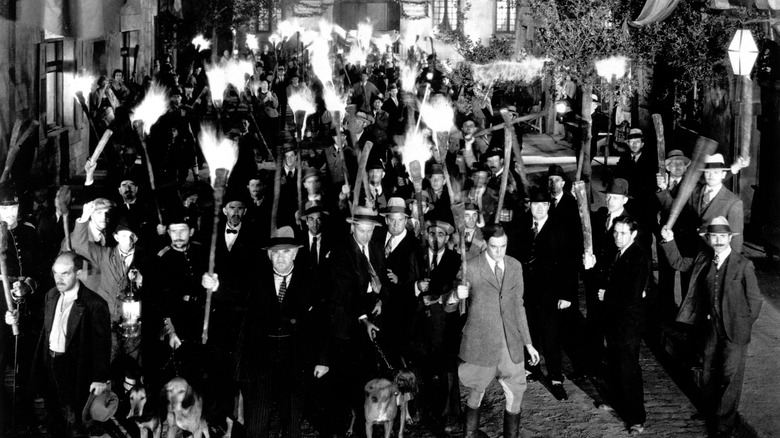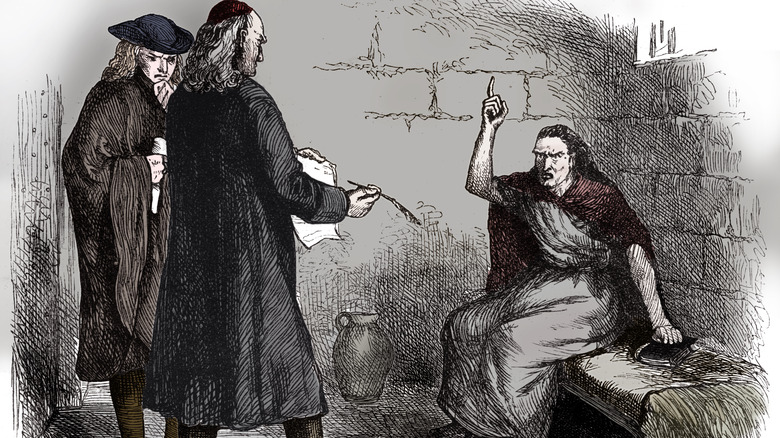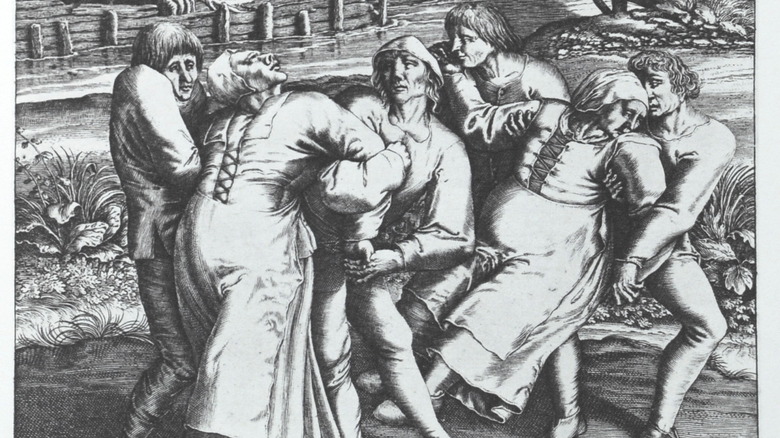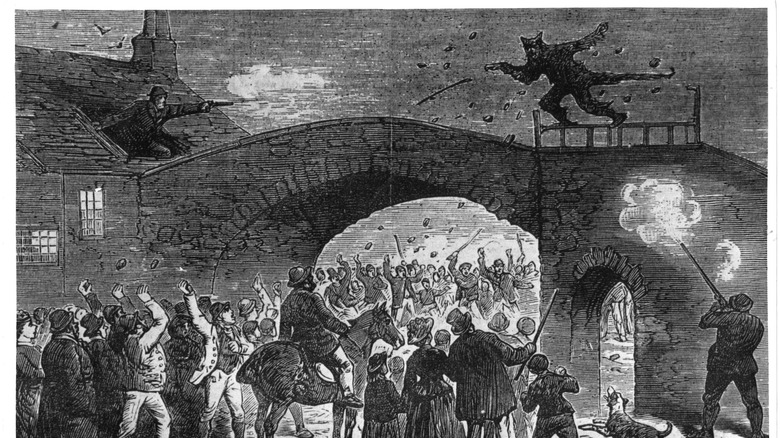Terrifying Historical Examples Of Mass Psychosis
Few scenarios frighten us quite like the prospect of losing our minds. The irony lies in the fact that as human beings, we are utterly reliant upon this instrument to guide us through life, yet the very thing that feeds our intellect remains a mystery. In this way, our own brains have already outsmarted us. According to Stanford Medicine, renowned neurobiologist Lu Chen once said: "We know very little about the brain. We know about connections, but we don't know how information is processed."
As such, we walk the Earth with knowledge of what little knowledge we have, ever aware of our mind's fragility. To make matters worse, there's more to insanity than meets the eye. Insanity, by definition, is a state of disorder, of chaos (via Merriam-Webster). It is also not limited to a singular person, as humans were never designed to live on our current level of individualism (more on that later). Rather, we are hard-wired to maintain a social structure, per a study archived on the U.S. Library of Medicine. It is within that structure that we find order through things like routine, codification, and hierarchy. By maintaining order, we keep ourselves sane.
Did you know the human brain is so fragile that entire social structures can collapse, giving way to a phenomenon known as mass psychosis or mass hysteria? From the Salem witch trials to the dancing plague, history is wrought with instances where entire societies collectively spiraled into madness.
The Salem witch trials are some of the most notorious examples of mass psychosis
According to History, the Salem witch trials first came into existence after local girls in Colonial New England experienced bouts of violent contortions followed by screaming fits and peculiar illnesses. Rather than chalking the unfortunate events up to mental or physical health conditions, townspeople immediately drew the conclusion that these events were the work of witchcraft. Their claim was led and/or supported by Dr. William Griggs, who named "bewitchment" as the official health diagnosis.
Between 1692 and 1693, a surplus of more than 200 people stood accused of witchcraft. Nineteen of the accused would experience horrifying deaths by hanging. One unfortunate fellow by the name of Giles Corey was crushed to death in a slow and painful public spectacle (via All That's Interesting). Interestingly enough, anyone who spoke out against the trials would inevitably wind up on the list of accused, causing some concerned citizens to simmer in silence.
Some scientists claim this notorious slaughtering under the guise of witchcraft was caused by the fungus ergot — a toxic mold sometimes found in foods that were popular in that region and time. The fungus is known to cause physical illness, including delusions and muscle spasms. Still, others make a strong case for collective mental stress in the midst of war, famine, and disease. It's notable to point out that while the cause is unclear, the victims consisted of social outcasts. It's as if these townspeople's warped minds were subliminally sentencing people to death simply because they didn't like them. From this perspective, perhaps the accusers were victims of a dark magic that crept into their own minds and created for them an excuse to murder those they deemed less worthy.
The dancing plague of 1518 brought mass hysteria to the stage
When a woman by the name of Frau Troffea twirled along the streets of Strasbourg in mid-summer of 1518, it was quite the show. History reports that she embarked on a week-long "solo danceathon" with no music to accompany her smooth moves. Naturally, her neighbors hailing from the Ancient Roman Empire had no choice but to ... join her? What followed was a 400-person dance-off later documented as an epidemic.
The dance-off continued well into August, at which point authorities got involved ... and saw to it that the dancers were given a suitable stage and provided with background music to keep the party going. Doctors all across town unanimously agreed that dancing was both the illness and the cure. They too encouraged locals to gyrate, shake, twist, and twirl for months on end. This sounds silly and innocent until you learn that many of the participants quite literally danced themselves to death, collapsing in the streets from exhaustion, heart attacks, and strokes. It was such a bizarre incident you would think it could never happen again — except it did. Historical records from the 16th century are absolutely brimming with instances where entire towns were bitten by the "jitterbug" and ultimately wound up dancing themselves to death.
Scientists again suspect the infamous fungus ergot, which seems to really have been wreaking havoc back then. Other experts cite stress-induced hysteria brought about by widespread superstition.
One case of mass psychosis caused Victorian England to conjure the leaping demon Spring-heeled Jack
Spring-heeled Jack is the stuff of nightmares, no doubt. He was described by residents of Victorian England as a kind of demon on springs leaping about, terrorizing Victorian ladies with maniacal laughter and cunning, clawed hands. Between 1837 and 1838, there are widespread accounts of this immortal creature engaging in all sorts of illicit activity. Spring-heeled Jack was perhaps most notorious for ripping women's clothing off and hurdling over bridges. History Daily called him a "homegrown boogeyman," and his face and graphic depiction are prevalent in urban folklore to this day.
The biggest problem with Spring-heeled Jack is the fact that he is the product of a collective hallucination. Historians remain baffled by the sheer number of accounts of this maniacal villain. Like a real-life supervillain straight out of the pages of your favorite comic book, Spring-heeled Jack was even featured in the news.
Experts claim this mass hysteria was brought about by the pangs of the Industrial Revolution and growing socio-economic stress. However, they have not completely ruled out the theory that Spring-heeled Jack might have existed as some kind of mean-spirited aristocrat playing mind games with the masses.
1962 marks a time of mass psychosis when everyone was cracking up
There was a time not long ago when laughter was quite literally putting people in stitches. Enter the laughter epidemic of Tanganyika, an event that had a thousand people cracking up.
Atlas Obscura reports that the incident started in a Tanganyika school when a young girl fell into a fit of uncontrollable laughter. If you've ever been tickled too long, you know the feeling. It is comprised of equal parts excitement, terror, dizziness, and delight. Over the course of the months that followed, approximately a thousand people were stricken with the sickness, causing 14 local schools to completely shut down. Symptoms of the so-called illness included fits of laughter lasting for weeks on end, followed by a kind of crying jag that was sometimes accompanied by violent episodes — certainly no laughing matter after all.
Some experts cite pressures from recent British rule as the cause for this case of mass hysteria.
Some experts suggest we are currently in a state of mass hysteria
Remember that individualism that was mentioned at the beginning of this article? Well, some experts believe that our current state of existence — which some say is a toxic combination of individualism and consumerism — is driving our current society mad. An article first published in the International Journal of Environmental Research and Public Health and later displayed online by the U.S. National Library of Medicine makes the following claim: "Negative information which is spread through mass media repetitively can affect public health negatively in the form of nocebo effects and mass hysteria. We argue that mass and digital media in connection with the state may have had adverse consequences during the COVID-19 crisis."
At this point, you are probably thinking that's crazy, which is fine — that is precisely what someone stricken by mass hysteria would say. Besides, you're probably right. After all, it's been well over a year since you've had to fist-fight your neighbors for bottled water and rolls of toilet paper. Your children are back in school again, where shootings are common and face masks are the norm. You just finished uploading vacation pictures on your social media webpage, which is basically a scrolling timeline of some unrealistic, parallel universe where a happier version of yourself and your entire family exists for all the world to see. The U.S. suicide rate is the highest on record since World War II (via Time), accounting for one out of every 100 deaths (via the World Health Organization).
Due to the nature of mass hysteria, such crises would be difficult — if not impossible — for a person living inside of it to identify. As the minds of the masses collectively cave in, any lone person pointing out the defects would be labeled a deviant themselves, henceforth spawning even more mass insanity. From a hypothetical standpoint, it is amusing to ponder what this moment, if deemed hysterical, might be called in the future. Perhaps "The Toilet Paper Wars?" Only time will tell.
If you or anyone you know is having suicidal thoughts, please call the National Suicide Prevention Lifeline at 1-800-273-TALK (8255).





